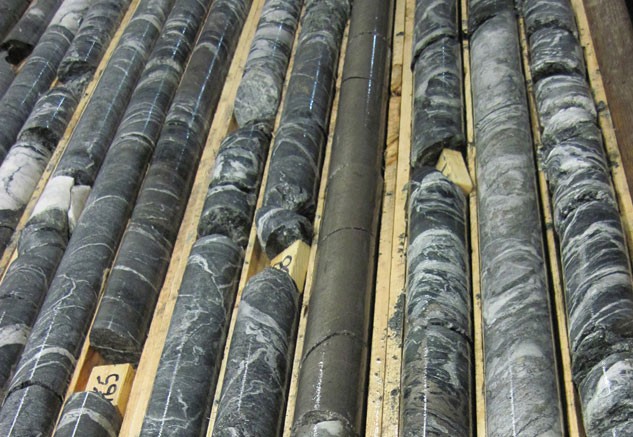Balmoral Resources’ (TSX: BAR) latest drill results provide further confirmation of new high-grade discovery at its Grasset nickel-copper-PGM project in Quebec, 600 km northwest of Montreal.
Horizon 3, a sulphide-rich mineralized zone that Balmoral discovered in May with hole intersecting 45.3 metres of 1.79% nickel, 0.19% copper, 0.22 gram platinum per tonne and 0.53 gram palladium, continues to return longer and higher-grade intercepts than previously discovered zones at Grasset, and Horizon 1 and 2.
Eight holes fanning out from the Horizon 3 discovery hole all hit high-grade mineralization over significant lengths.
Highlights include hole 28, which returned 103 metres of 1.03% nickel, 0.11% copper, 0.22 gram platinum per tonne, and 0.53 gram palladium, starting from 88.5 metres depth. That intercept included 54 metres grading 1.62% nickel, 0.18% copper, 0.36 gram platinum, and 0.88 gram palladium, which in turn, included a 16-metre section of 2.51% nickel, 0.32% copper, 0.66 gram platinum and 2.09 grams palladium.
Hole 33, the deepest to date at Grasset, delivered 100 metres of 0.95% nickel, 0.11% copper, 0.21 gram platinum, and 0.48 gram palladium from 141 metres, including a 9.8-metre section of 2.73% nickel, 0.33% copper, 0.68 gram platinum, 1.64 gram palladium and 0.11 gram gold.
In addition to nickel, copper and platinum group metals (PGMs), several of the deeper holes returned anomalous gold values (over 0.1 gram per tonne). Intervals are not true widths.
So far, Balmoral has traced nickel-copper-PGM mineralization at Grasset for over 840 metres along strike in three vertically oriented sub-parallel horizons that trend northwest. Horizon 3 is about 100 metres southeast of the other horizons.
Mineralization is open to the northwest and at depth, and occurs as heavy disseminated to massive sulphides in multiple stacking horizons within the ultramafic complex.
The deposit is situated at the southern end of the 16-km-long, northwest-trending Grasset ultramafic intrusion complex, at the northern contact with the Sunday Lake deformation zone.
Darin Wagner, Balmoral’s president and CEO, says that with the latest results, the company has started to outline the potential of a high-grade nickel-copper-PGM sulphide zone in the Grasset ultramafic complex.
“Ongoing drilling continues to intersect broad zones of sulphide mineralization, both along strike from, and beneath, the holes reported today,” Wagner said in a release. “With continued strong results, regional geophysical work ongoing and the tendency of magmatic nickel sulphide systems to host multiple zones of nickel mineralization, we are increasingly optimistic about the potential of this trend, which is 100% controlled by Balmoral.”
The southeastern-most drill hole, hole 34, hit a zone of deformed ultramafics cored by a porphyry dyke — which Balmoral believes to be an east-west trending, near-vertical fault offsetting the Horizon 3 zone. The presence of Grasset ultramafic-complex rocks on both sides of the fault suggests the fault has offset the zone to a limited extent. The company will resume testing to the southwest of the fault once it receives data from a magnetic airborne survey currently under way.
Balmoral is also conducting a drill program at its Martiniere gold project, 40 km west of Grasset and 45 km east of Detour Gold’s (TSX: DGC) Detour Lake gold mine.
Balmoral shares traded 11¢, or 6%, higher on the news to $1.92. The shares have traded in a 52-week range of 29.5¢-$1.98. Balmoral has 102 million shares outstanding.


Be the first to comment on "Balmoral delivers more high-grade nickel-PGMs at Grasset"